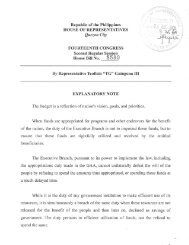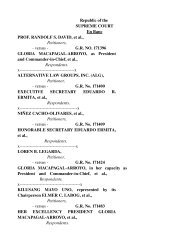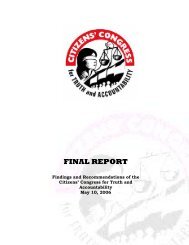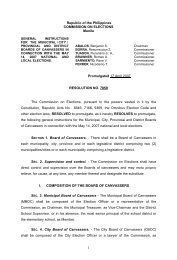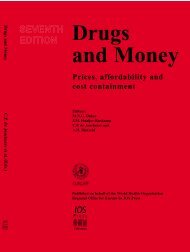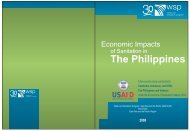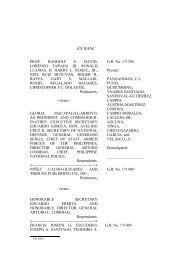i Report Issue No. 3 2005 - Philippine Center for Investigative ...
i Report Issue No. 3 2005 - Philippine Center for Investigative ...
i Report Issue No. 3 2005 - Philippine Center for Investigative ...
Create successful ePaper yourself
Turn your PDF publications into a flip-book with our unique Google optimized e-Paper software.
T H E L O S T G E N E R A T I O N<br />
olds. As women metabolize<br />
alcohol differently than men,<br />
they reach higher peak blood<br />
alcohol levels with the same<br />
amount of drink, making them<br />
at higher risk <strong>for</strong> medical<br />
problems.<br />
ACCORDING TO NPCIS, the<br />
accepted universal definition of<br />
moderate drinking is, <strong>for</strong> males,<br />
no more than three standard<br />
drinks per session or 15 per<br />
week; and <strong>for</strong> females, no more<br />
than two standard drinks per<br />
session or 10 per week. “Standards”<br />
vary by drink; one regular<br />
320-ml beer bottle is standard<br />
and so is a glass of wine. Ditto<br />
with a shot of gin. Beyond<br />
these standards, the behavior is<br />
considered “at risk.”<br />
“Tama lang naman ang<br />
pag-inom namin<br />
(We drink<br />
just right),” fresh college graduate<br />
Marissa insists. Her friends<br />
say the same thing; they set<br />
limits. Rona, <strong>for</strong> example, will<br />
have no more than two bottles<br />
of San Mig Light or a bottle<br />
and a half of the stronger Red<br />
Horse in one sitting. Using the<br />
NPCIS definition, they would<br />
seem “moderate” drinkers.<br />
In general, local experts<br />
define drunkenness at a blood<br />
alcohol level of 0.1 percent<br />
or 100 mg/dL. The amount of<br />
alcohol that one needs to take<br />
in to be intoxicated actually<br />
varies, and depends on factors<br />
such as gender, age, body<br />
weight, and metabolism rate.<br />
For a normal, 15-year-old girl<br />
who weighs 50 kgs., <strong>for</strong> example,<br />
intoxication can come<br />
after she drinks nearly three<br />
320-ml bottles of pale pilsen,<br />
or just a smidgen more than a<br />
365-ml bottle of strong beer, or<br />
two 50-ml jiggers of gin.<br />
Elsewhere, experts define<br />
binge drinking as having a<br />
blood alcohol level of 0.08<br />
percent or 80 mg/dL. Tan<br />
quotes New Scientist<br />
as saying<br />
that “on average, males taking<br />
in five or more ‘standard<br />
drinks’ or females taking<br />
in four or more ‘standard<br />
drinks’ in two hours send<br />
blood alcohol soaring to that<br />
80-milligram level.” But he<br />
notes that since the magazine<br />
is talking of Western bodies,<br />
Filipinos would probably need<br />
less than that in less time to be<br />
considered “binge drinkers.”<br />
Panganiban herself is not<br />
at all reassured with all this<br />
talk of moderation. “Thresholds<br />
are naturally pushed up,”<br />
she says. Jang, <strong>for</strong> instance,<br />
began drinking with a limit<br />
of two Red Horse bottles per<br />
session. <strong>No</strong>w she can drink<br />
three bottles and not even feel<br />
slightly tipsy. Her friends have<br />
an even higher tolerance—or<br />
so they think. MJ, also 16,<br />
can drink up to eight bottles<br />
of beer in one sitting without<br />
feeling drunk. But experts<br />
have repeatedly emphasized<br />
that there are people who do<br />
not show or feel the effects<br />
of having dangerous levels of<br />
alcohol in their systems. More<br />
often than not, the realization<br />
comes only after they have<br />
already figured in an accident<br />
or wake up in a hospital.<br />
MJ, though, is unperturbed.<br />
“Sometimes, my drinking buddies<br />
are my aunts,” she says.<br />
“They say it’s okay so long as I<br />
don’t drink too much.”<br />
College lecturer Carole<br />
Diamante, who teaches at an<br />
exclusive girls’ school, feels<br />
habitual drinking may have<br />
harmful consequences. But<br />
she says she tries to understand<br />
her students who drink.<br />
“I guess I’m just indulgent by<br />
nature,” she says, laughing at<br />
herself. Diamante says students<br />
like drinking because “alcohol<br />
brings out the spirit.” She’s a<br />
theology teacher, and she and<br />
her students have noted that<br />
Jesus shared a goblet of wine<br />
with the Apostles, urging them<br />
to drink in His memory after<br />
His death.<br />
To Diamante, the students’<br />
drinking is akin to the way<br />
ordinary wage earners turn to<br />
bottles of beer to relieve their<br />
workday aches and pains. She<br />
says academic life can be just<br />
as stressful. “So they binge,”<br />
she says of her students.<br />
“(They) enjoy the moment<br />
because they know they will<br />
(soon) go back to reality.” She<br />
says her students even drink<br />
with their parents, a setup that<br />
she believes helps rein in the<br />
youngsters. “They tell their<br />
daughter, ’O, not the very hard<br />
drink ha,’” says Diamante. “Or,<br />
‘On the rocks lang ha.’”<br />
THERE ARE indeed several<br />
youngsters who are drinking<br />
openly with their friends at<br />
home. But many times, adult<br />
supervision is lacking because<br />
both parents are too busy either<br />
with work or attending to<br />
the rest of the family. Meanwhile,<br />
outside, the drinking<br />
continues in bars and restaurants,<br />
especially <strong>for</strong> college<br />
students, who imbibe even<br />
during lunch and merienda.<br />
There are schools that have<br />
had to ask nearby restaurants<br />
not to serve alcohol during<br />
the day so that their students<br />
will stop showing up in class<br />
tipsy—that is, if these show<br />
up at all. Apparently, the<br />
restaurants assume college<br />
students are all at least 18,<br />
the legal drinking age, and it<br />
is there<strong>for</strong>e okay <strong>for</strong> them to<br />
drink.<br />
College teachers also say<br />
there are students who bring<br />
alcohol-filled thermoses, the<br />
contents of which are usually<br />
chugged inside the rooms of<br />
the various school organizations.<br />
Teachers who pick up<br />
on the distinct smell of beer<br />
reprimand the students, who<br />
appear contrite and swear<br />
never to bring the brew to<br />
school again. But that is a<br />
promise writ in air, and it<br />
quickly dissipates even be<strong>for</strong>e<br />
the teachers’ backs are turned.<br />
“Our society,” says anthropologist<br />
Valbuena, who is with<br />
the Health Action and In<strong>for</strong>mation<br />
Network (HAIN), “has<br />
yet to regard alcohol drinking<br />
as a problem.” This is despite<br />
a high awareness that those<br />
who drink are more likely to<br />
engage in other risk behaviors.<br />
Alcohol impairs decision-making<br />
abilities and reflexes; studies<br />
done abroad have shown<br />
alcohol as a factor in as much<br />
as 30 percent of all vehicular<br />
accidents.<br />
In HAIN’s own focus-group<br />
discussions <strong>for</strong> the qualitative<br />
component of YAFS3, participants<br />
said they were more<br />
likely to have sex after drinking.<br />
In the United States, it<br />
is estimated that teenage girls<br />
who binge drink are up to 63<br />
percent more likely to become<br />
teen mothers.<br />
“It’s not automatic,” cautions<br />
adolescence expert Conaco.<br />
“But you’re drinking, your<br />
inhibitory senses are depressed,<br />
and you’re fooling around with<br />
your boyfriend? The same way<br />
you say do not drink and drive?<br />
Do not drink and date.”<br />
Marissa says this is why<br />
she puts limits on her drinking<br />
and stops be<strong>for</strong>e she becomes<br />
unable to think clearly. “We’ve<br />
had friends who became<br />
pregnant because they were<br />
drunk,” she says. Stories of<br />
date rapes also abound.<br />
Jang and her friends tell<br />
similar tales. “When you’re<br />
drunk, you don’t know what<br />
you’re doing,” Jang says.<br />
That’s why she says she and<br />
her friends are careful. Whenever<br />
her parents scold her<br />
about her drinking, Jang also<br />
tells them that she knows the<br />
consequences of drinking too<br />
much, and that they need not<br />
worry.<br />
“They’re not ignorant,” demographer<br />
Cruz concedes. It’s<br />
just that they have been unable<br />
to resist the call of the bottle, a<br />
call magnified as much by the<br />
desire of alcoholic-drink manufacturers<br />
to increase profits<br />
as it is by changes in societal<br />
attitudes.<br />
42 PHILIPPINE CENTER FOR INVESTIGATIVE JOURNALISM I REPORT



